This thought process is randomly interrupted by my family’s cat, who is loudly complaining that our presence in her house at this time of the day is unwelcome and interferes with her 12-hour nap. However, the time to reflect has been fruitful, and I’d like to share some of my thoughts with you.
About the study
During the past four years, we have been working with integrating summer cover crops into a wheat pasture stocker grazing system. Our main objective is to determine the effect of these summer crops on subsequent production of the wheat pasture.
The study area is located on a Noble Research Institute farm west of Ardmore, Oklahoma. The study area is a 100-acre field that was randomly divided into 10 10-acre paddocks about 20 years ago and assigned to either a tillage or no-till winter pasture stocker production system. During the summer, the land area was fallowed either with tillage or chemically.
For our cover crop study, we subdivided each of the 10-acre paddocks into 5-acre paddocks then assigned a cover crop treatment to one side. This resulted in a whole-plot-split-plot study design where the whole-plot is tillage (tillage or no-tillage) and the split-plot is the summer cover crop (summer cover crop or summer fallow). The study has five replications of each combination: tillage summer fallow (Till), tillage summer cover crop (TillCC), no-till summer fallow (NT) and no-till summer fallow (NTCC).
The objectives are to compare the effects of summer cover crop or summer fallow by tillage method on forage biomass production, water infiltration, soil bulk density, soil moisture, soil microbial community, animal performance and system economics. Both the winter pasture and summer cover crops are grazed with stocker cattle. Table 1 is a timeline of the system.

During the course of this study, we have collected a tremendous amount of data and spent a lot of time crawling around in the soil in an attempt to develop a deeper understanding of the interactions occurring between the soil, water, plant and the functioning ecosystem. In research, once a protocol is established, we don’t deviate from it for at least two to three years, because we want to be able to definitively say what impact our treatment effects have over time. There is never a perfect research study.
There are always things you wish could have been done differently, added to the study or changed. However, some of these issues turn out to be great sources of practical knowledge that can lead to enhanced management strategies. Reflecting back over this study, here are some of the issues and observations we have encountered and some research-based takeaways you can use as decision aids in your operation.
Environment
We have no control over the environment. This is why we do multiple-year studies. The longer the better so that we have an idea of treatment effects over the long term. The environment we are conducting our study in is challenging. Wet springs followed by hot, dry summers make it difficult to maintain crop residue and build organic matter. We literally watch crop residue disappear, as well as a lot of soil moisture to evapotranspiration, during the summer. This also limits the number of productive summer crop species we can use. The window of time for our cover crop is narrow, generally from April to September.
Our advice is to choose cover crops that fit your environment and fit your cover crop need. For example, soybeans do not work well for us in a mix but cowpeas do. In the Midwest, soybeans probably fit very well in a cover crop grazing mix.
Weed control
Weeds can be a big issue in summer cover crops. In our study area, we have an issue with pigweeds. If our cover crops are planted in April or early May and we get a jump on the pigweeds, cover crops can do a good job of pigweed suppression. If pigweeds get a jump on the cover crop, then we have problems with control if broadleaf cover crops are in the mix.
In 2019, we applied a broadleaf herbicide over our cover crops for pigweed control, resulting in the loss of our broadleaf components. Consideration of potential or current weed issues is important for summer cover crop success.
Time
Timing is a big issue in this study. In the NT and NTCC paddocks, we can apply a burn-down herbicide and, if moisture conditions are favorable, plant. In Till systems, getting soil moisture right for seedbed preparation leads to time spent waiting for the right conditions to occur. In some years, field condition delays have resulted in TillCC being planted 37 days behind NTCC. This timing advantage aids with weed suppression and potentially lengthens the grazing period.
In the TillCC system, because of the later planting date, cover crop production may not peak until August or September, which is also the time period when they should be terminated to allow for establishment of winter pasture.
Flexibility of cover crop utilization
One question always leads to another. In the timeline of the current study in Figure 1, we graze one set of cattle on winter pasture and a second set of cattle on the cover crops.
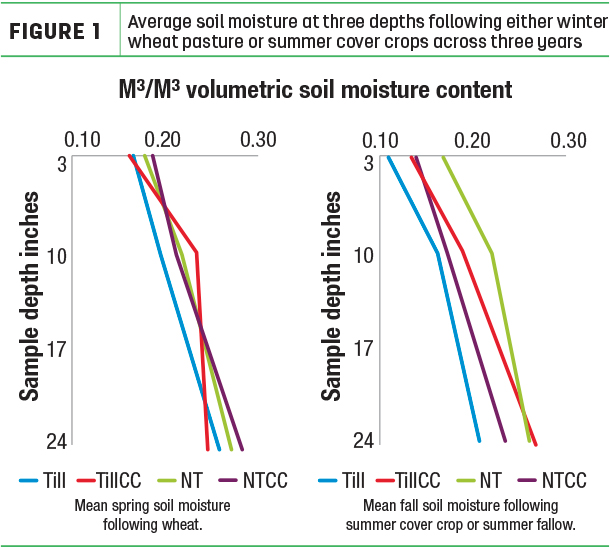
Due to the short summer grazing period, we have found it difficult to achieve enough grazing days for cattle grazing to be profitable (Table 2).
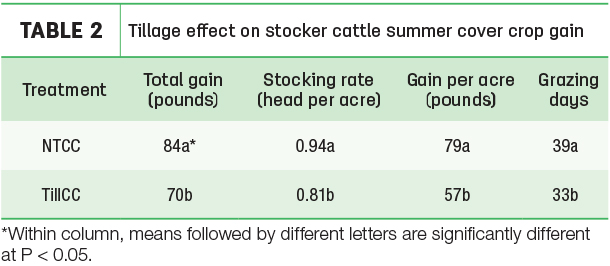
These grazing days usually occur in late summer, which may give us the opportunity to receive cattle onto a cover crop in late summer prior to the development of winter pasture. This concept addresses a common problem producers face: late summer and early fall forage availability for stocker calves prior to the development of cool-season annual pastures. Late-season summer cover crops may provide that answer and is a direction to take our studies.
Soil moisture and infiltration
Soil moisture has been interesting to track during the study. Prior to the study’s initiation, we hypothesized production differences due to treatment effects could be explained by soil moisture. In Figure 1, average soil moisture of TillCC and NTCC falls between the Till and NT summer fallow treatments. This would indicate that cover crop treatments are using water compared to NT summer fallow but not to the extent that the Till summer fallow is losing moisture due to evapotranspiration.
In addition to measuring soil moisture, we also measure soil temperature. Peak soil temperatures of Till soils during the summer have measured higher than 110ºF. Temperatures this high have a negative effect on soil microbes and soil moisture. Cover crops provide a shading effect that cools soils to help preserve soil moisture compared to Till and maintain a broader soil microbial population. Note that following wheat, soil moisture lines converge.
Data from water infiltration is noisy, and we have not been able to detect tillage or cover crop treatment effects on infiltration. Water infiltration rates seasonally fluctuate with higher infiltration rates in hot, dry soils in the summer compared to lower rates in cool, moist soils in the spring. What we have observed is that the crop residue generated by NT holds rainfall on the soil longer, allowing it to infiltrate rather than runoff compared to Till soils.
Volunteer cover crops
For the first two years of the study, we used a cover crop multispecies mix consisting of a 50/50 mix of summer annual grasses and broadleaves. We noted that some of the species in the mix contributed very little to biomass and were eliminated. In the Till system, we noted that what we planted persisted. In our NT system, we had a tremendous amount of volunteer annual grasses, predominately crabgrass, which competed heavily with our planted cover crop. Crabgrass is an excellent summer forage and provided good summer grazing.
The moral of the story is, sometimes a volunteer crop can be your best cover crop.
Stocker gain
Table 3 shows the average winter pasture stocker cattle gains by tillage system and cover crop.
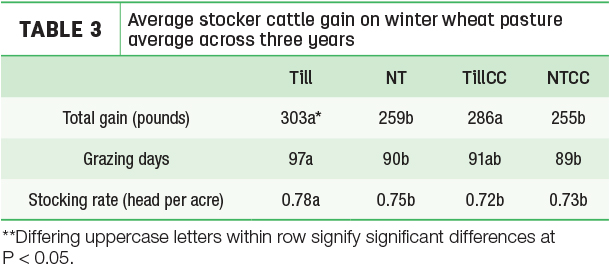
Winter pasture gains of stocker cattle are higher in Till systems compared to NT systems. This result is interesting when you consider that soil moisture is more limiting in the Till system compared to the NT system. Also note that stocking rate and grazing days on winter pasture are below what you normally think the stocking rate would be. In year two and three of the study, we had an extremely wet fall followed by an extremely dry fall that limited grazing to the spring period only.
What we are seeing is that winter pasture paddocks that follow a summer cover crop begin to run out of nitrogen in the spring. This is another research question we need to follow up on but as a producer, it needs to be considered. Our cover crop mix consist of approximately 45% cowpeas, and, to this point, we have not been able to capture a nitrogen benefit from the inclusion of the legume.
Organic matter
We know of the tremendous benefits of adding organic matter to soils. Building organic matter takes biomass and time and will be influenced by environment. Figure 2 is the treatment average organic matter content tracked during the study.
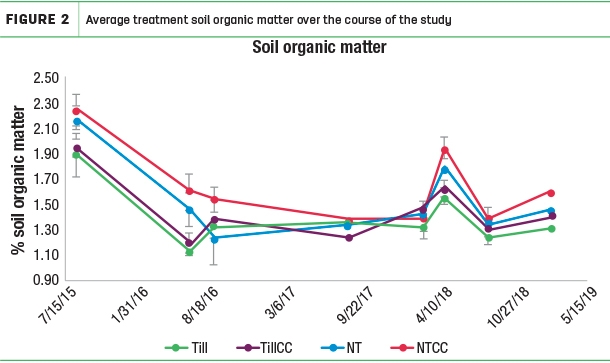
Note that NT and NTCC organic matter content is higher compared to Till and TillCC soils. Building organic matter is a slow process, and don’t be disappointed if the addition of a cover crop does not dramatically influence organic matter.
Soil erosion
A big impact of NT and cover crops during this study has been a reduction of soil erosion. As seen in Image 1, the largest areas impacted by soil erosion are in our Till paddocks (1, 2, 4, 5 and 8).
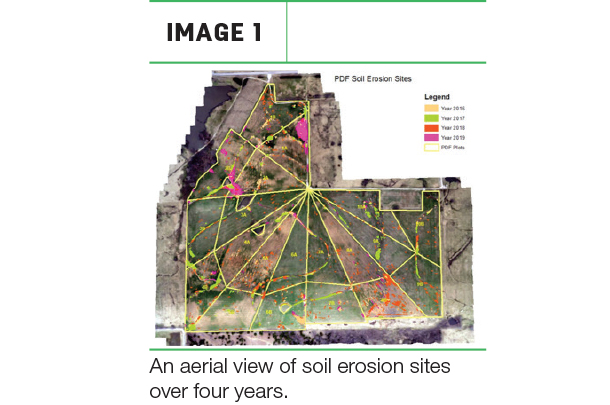
In paddock 2, we have estimated the movement of soil out of this paddock to be 80 tons. In areas where we have cover crops, the erosion impact is minimal.
We are producing more total forage biomass with the inclusion of the summer cover crops compared to summer fallow. Our continued challenge is to develop the best management practices for the utilization of this additional mass. While the summer cover crops do use soil moisture, the shading effect and cooler soil temperatures reduce soil moisture losses to evapotranspiration compared to Till summer fallow soils.
There are continued challenges that we face utilizing summer cover crops, such as weed pressure and adjusting fertility rates. These challenges can be met with flexible management that can take advantage of seasonal availability of cover crop forage. It is also important to understand what weed pressure issues you may face when adding a summer cover crop and adjust your crop species and time of planting accordingly. ![]()

-
James Rogers
- Associate Professor
- Noble Research Institute
- Email James Rogers









